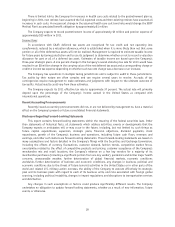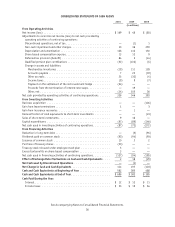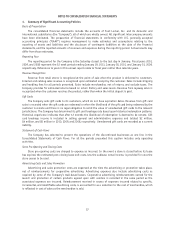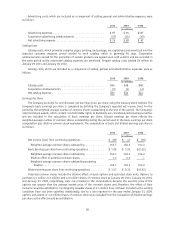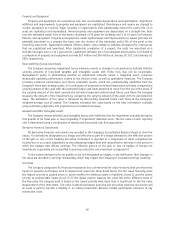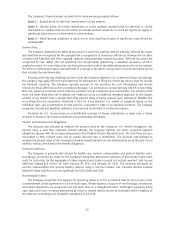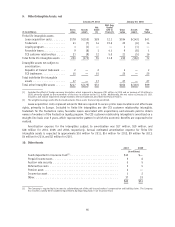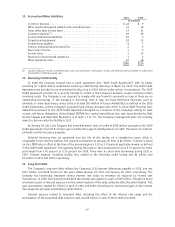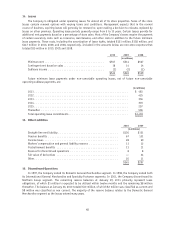Foot Locker 2010 Annual Report Download - page 58
Download and view the complete annual report
Please find page 58 of the 2010 Foot Locker annual report below. You can navigate through the pages in the report by either clicking on the pages listed below, or by using the keyword search tool below to find specific information within the annual report.Share-Based Compensation
The Company recognizes compensation expense in the financial statements for share-based awards based on
the grant date fair value of those awards. Additionally, stock-based compensation expense includes an estimate
for pre-vesting forfeitures and is recognized over the requisite service periods of the awards. See Note 21,
Share-Based Compensation, for information on the assumptions the Company used to calculate the fair value of
share-based compensation.
Upon exercise of stock options, issuance of restricted stock or units, or issuance of shares under the
employees stock purchase plan, the Company will issue authorized but unissued common stock or use common
stock held in treasury. The Company may make repurchases of its common stock from time to time, subject to
legal and contractual restrictions, market conditions, and other factors.
Cash and Cash Equivalents
Cash equivalents at January 29, 2011 and January 30, 2010 were $675 million and $501 million, respectively.
Included in these amounts are $165 million and $207 million of short-term deposits as of January 29, 2011 and
January 30, 2010, respectively. The Company considers all highly liquid investments with original maturities of
three months or less, including commercial paper and money market funds, to be cash equivalents. Additionally,
amounts due from third party credit card processors for the settlement of debit and credit card transactions are
included as cash equivalents as they are generally collected within three business days.
Investments
Changes in the fair value of available-for-sale securities are reported as a component of accumulated other
comprehensive loss in the Consolidated Statements of Shareholders’ Equity and are not reflected in the
Consolidated Statements of Operations until a sale transaction occurs or when declines in fair value are deemed
to be other-than-temporary. The Company routinely reviews available-for-sale securities for other-than-
temporary declines in fair value below the cost basis, and when events or changes in circumstances indicate the
carrying value of a security may not be recoverable, the security is written down to fair value. The Company’s
short-term investment was valued at $7 million at January 30, 2010; this amount was received during 2010. The
Company’s auction rate security was valued at $5 million at both January 29, 2011 and January 30, 2010. See
Note 19, Fair Value Measurements, for further discussion of these investments.
Merchandise Inventories and Cost of Sales
Merchandise inventories for the Company’s Athletic Stores are valued at the lower of cost or market using
the retail inventory method. Cost for retail stores is determined on the last-in, first-out (‘‘LIFO’’) basis for
domestic inventories and on the first-in, first-out (‘‘FIFO’’) basis for international inventories. The retail inventory
method is commonly used by retail companies to value inventories at cost and calculate gross margins due to its
practicality. Under the retail inventory method, cost is determined by applying a cost-to-retail percentage across
groupings of similar items, known as departments. The cost-to-retail percentage is applied to ending inventory at
its current owned retail valuation to determine the cost of ending inventory on a department basis. The Company
provides reserves based on current selling prices when the inventory has not been marked down to market.
Merchandise inventories of the Direct-to-Customers business are valued at the lower of cost or market using
weighted-average cost, which approximates FIFO. Transportation, distribution center, and sourcing costs are
capitalized in merchandise inventories. The Company expenses the freight associated with transfers between its
store locations in the period incurred. The Company maintains an accrual for shrinkage based on historical rates.
Cost of sales is comprised of the cost of merchandise, occupancy, buyers’ compensation and shipping and
handling costs. The cost of merchandise is recorded net of amounts received from vendors for damaged product
returns, markdown allowances and volume rebates, as well as cooperative advertising reimbursements received in
excess of specific, incremental advertising expenses. Occupancy includes the amortization of amounts received
from landlords for tenant improvements.
39


